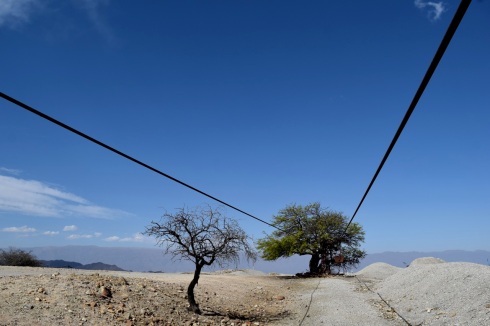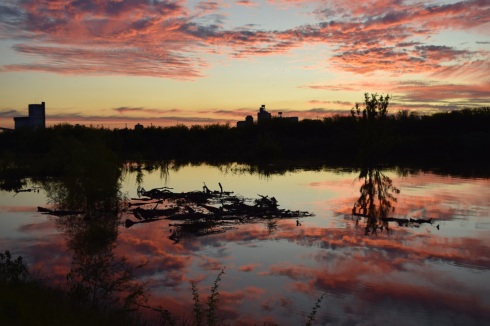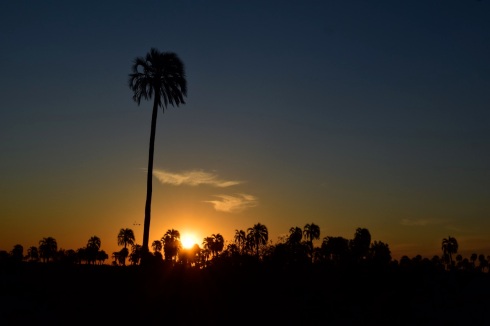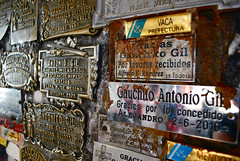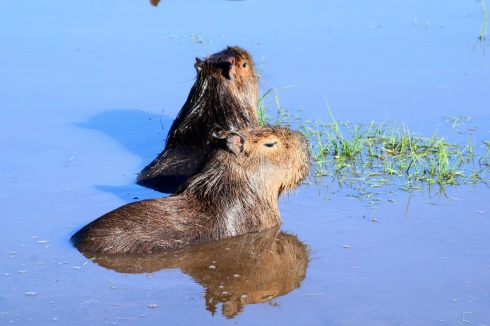
Down by the riverside: Capybaras bathing in a stream, Parque Nacional El Palmar, Entre Rios, Argentina.
Caraiva, Bahia, Brazil
[by Paula]
As we traversed Argentina for the fifth time in just over a year, it felt like a lot of the things we were seeing and doing were something of a preparation for the next phase – Brazil. Which is where we are now, although we still can’t quite believe we finally made it here.
As we headed back towards the Entre Ríos (‘between rivers’) province near the Argentina/Uruguay/Brazil border, things became just that little bit more tropical – lush landscapes, more exotic wildlife, plenty of rain, increased warmth and humidity, and a sudden rise in the size and volume of the insects that wanted to come and live in the van. The rivers flanking the province – the Rio Paraná and Rio Uruguay – both flowed into Brazil and we were increasingly content to be carried along with them.
But before our time down by the riverside, we had one last date with Argentina’s mountains. When we last wrote, we were on our way to Chilecito, in the hills of La Rioja. La Rioja?… ah, there they go chasing wine again, I hear you say. But no, we were there for its dramatic highland setting and its fascinating abandoned cableway system, which once trundled gold, silver and copper between the mine – up in the sierras at an altitude of more than 4,600m – and the town. An amazing early 20th century feat of engineering, the cableway spanned 40km and had nine stations.
We visited a cute little museum at ‘station 1’ before driving up to ‘station 2’ for some fabulous views and a wander among the cablecar graveyard.
We headed down to the sierras around Córdoba, stopping off in Villa de Soto to meet up with fellow road-trippers Betti and John, from the UK. We’d never met before but Betti had responded to my pathetic Facebook plea for some British teabags. A month or so later they were in the vicinity and before we knew it we were meeting up for a barbeque and the ceremonial handing over of a batch of hugely appreciated PG Tips. Aaah…. a lovely cuppa.
Amongst other things we chatted about Brazil, as we were still humming and hawing about whether to make the massive trip.
In lovely Alta Gracia we paid tribute to the revolutionary that graces more t-shirts than he could ever have imagined, Ernesto ‘Che’ Guevara, who lived in the town as a child. After wandering the family’s old home, now a museum and photo exhibition, we visited the new souvenir shop across the road. I think they succeeded in ensuring no one was in any doubt that this was the Che shop….
We took the bus to the bright lights of Córdoba, which was our first cosmopolitan city day in a long while. We made the most of it by pounding the streets, ‘doing’ the sights, and working up an appetite for a proper Argentinian parrilla lunch of grilled meat, with grilled meat and grilled meat.
Córdoba’s massive student population helps to give it that hip edge. The fact that we were so excited by all the cool cafes, antique shops, market stalls and thronging bars made us realise we’d been knocking around in the backwaters for rather too long. To mark the occasion we had a cocktail before heading for the bus back to our provincial campervan.
We were getting some lovely sunny days but the spring weather was still pretty mixed, which only made us dream of Brazilian beaches even more. By the time we left the sierras we’d made a final decision that we’d keep heading east and go for it.
When we reached Santo Tome, on the Rio Paraná in Santa Fe, we were in organisational mode. We had this irrational compulsion to ‘get prepared for Brazil’, as if we were heading for some back-of-beyond third world country. This kind of thing happens to me even when we’re about to cross borders between the Spanish-speaking countries of Latin America. I start doing low-level panic-buying in case across the frontier ‘they’ don’t have certain foodstuffs or the brand of tea I like. We also knew wine was expensive and more limited in Brazil – into the trolley it goes!
Being addicted to change doesn’t mean you don’t also fear it in some small way.
With Brazil we had all the usual trivial uncertainties, but with the added complication that we don’t speak Portuguese. We were taking on a long drive in a relatively short space of time and had some fairly important things to sort out, which we really wanted to avoid having to deal with in a new language. One of those was replacing our close-to-death auxiliary battery, which powers the campervan lights and some plug sockets and enables us to camp without external power for several days.
Having to do ordinary things like find battery shops, launderettes, mechanics, ironmongers and the like gives us an excellent reason to spend time in ordinary towns. We really enjoyed our few days in the municipal site in Santo Tome, camping alongside seasonal workers and artesans, and pottering about doing our chores. The site was right next to a long riverside promenade, where people jogged, played, fished, and passed the time with friends and the ubiquitous Argentinian mate (a bitter green tea) which most people carry on their person at all times.
The riverside communities have a whole different feel to other parts of Argentina – there’s more languid strolling as smells of fried fish waft around, not unlike a seaside resort.
We even got the chance to go to an ordinary football match across the river in Santa Fe – a fine battle between two of the bottom teams in the premier league, Colón de Santa Fe and Arsenal de Sarandí. We’ve been to many matches in Latin America and one of the best things about them is being among the fans in the stands, who are as fanatical as it’s possible to be. The drums and singing don’t cease for the full 90 minutes, and goals are celebrated with the ‘hinchas’ (fanatics) conducting songs and chants from below. The hinchas rule the school, draping themselves from the fencing, shouting themselves hoarse at every turn in the game, hanging banners that talk of their willingness to die for their team and draping flags so huge that half the ‘hinchada’ can barely see the pitch. It said something about the, erm, enthusiasm of the Colón fans that they’d had to build a moat between the pitch and the stands.
While we were waiting for our new battery to arrive we took off up the river to Cayastá. At the posh camping there we grilled some steaks and felt all summery as we looked out over to the river beach on a lovely evening. There were some pretty loud splashes in the water after dark. “Must be some massive fish in there,” we surmised.
Next morning, this chap emerged from the water and came lumbering up the beach.
Shortly afterwards his friend came looking for some discarded fish heads, and got lucky.

This iguana came up the beach to find discarded fish heads for snacking on. Cayasta, Santa Fe, Argentina.
Despite our love of Argentinian steak, like Mr Iguana, we were pretty excited about being by the river and able to find some fish to eat again.
For our wedding anniversary we headed down the ‘coast’ to a fish restaurant in the tiny village of Los Zapallos. With its sandy streets and sleepy feel, it doesn’t look like the kind of place you’ll find a decent restaurant. But tucked away in the corner of the village, La Vuelta del Pirata has been serving up a well-regarded fish menu since the 60s.
In true Argentine style it didn’t even open til 9pm. We sat down, starving. Señora Pirata (as she will henceforth be known) shuffled over in her cardie, doing one of those slightly scary auntie faces that is both stern and twinklingly kind. Before we could even speak she said: “It’s just fish, fish and fish, nothing else. I keep bringing it out, and you eat it!“. We took this to mean there was a fixed menu, but were a bit too dumbstruck to ask how many courses there were or what the price was.
“Great!” we said, “do you have a wine menu?“. She leaned over to our neighbouring diners’ table and grabbed the bottle of white they were drinking. “This is the best one, you can have a bottle of this.”
I asked in a quiet voice how much the wine was, not being comfortable with having to ask the price of something in a restaurant. In a voice a few decibels short of a foghorn she bellowed “IT’S 90 PESOS!“. We were really starting to like this woman – as my dad said when I told him about her, the world needs more eccentrics.
“As a special gesture for our wedding anniversary, we slept in the van in the street outside the restaurant and used the pee bottle as a toilet. Romance is not dead.”
The food started arriving and we wolfed it. Then more came, and more. We really should have asked what the menu entailed, so we could have paced ourselves. By the 8th course I had a haunted, begging look in my eyes, pleading ‘when will this stop?’.
With each course we asked her what kind of fish was in the dish. Oh, she didn’t like the food being interrogated! After the umpteenth time, she waved her arm towards the other diners, shouting “they know, ask them how good the milanesa is, they’re my most regular customers!”. They nodded their approval.
And it was, indisputably, delicious. All gut-busting 10 courses of it. Baked fish empanaditas, pate, fish ‘meatballs’, fried empanadas, breaded clams, milanesa with roquefort, fish lasagne, marinero (filet in batter with pepper sauce), whole grilled fish, and seafood casserole. As she removed the final dishes she cried out, “oh, I forgot to bring the fried fish!”. Señora Pirata’s idea of a joke – I wonder how long she’s been telling that one.
When the bill came, the food amounted to just over £7 (US$11) a head. No joke.
As a special gesture for our wedding anniversary, we slept in the van in the street outside the restaurant and used the pee bottle as a toilet. Romance is not dead.
New battery installed, holes in exhaust repaired and laundry done, we headed across to Concepción, near the Uruguayan border, for yet more admin – such as the quarterly headache of filling the propane tank and paying the fine for having overstayed our Argentina tourist visa, to allow us to leave the country.
We arrived looking forward to some camping on the Rio Uruguay, only to find the river was now on the road, and a guy was paddling around in a boat in what had been the campsite. “All the campsites in the town are under water!” said the helpful tourist information officer. Parts of Brazil were getting so much rain they’d had to open a dam upriver, flooding loads of places alongside it. Oh dear.
Instead we set up base on the city’s shiny new costanera, a safely concreted promenade with some lovely views and sunsets. It was massive, with a free outdoor gym and parking for hundreds of cars, but we had the place to ourselves each night.
Jobs done we headed north towards the border, stopping off for a final dose of tourism at El Palmar national park. One of the last major protected areas for the massively tall yatay palm trees, it had sounded lovely when we read about it. But we weren’t quite prepared for the strange feeling of entering a tropical paradise just a few kilometres from the highway.
As soon as we crossed the park boundary we saw fabulous, vivid birds, and hundreds of capybaras bathing in streams and ambling along the roadside. Curious little foxes stared at us from behind bushes, and in the evening little mustacheod viscachas (members of the chinchilla family) came trotting through the campsite looking for barbeque leftovers.
And then there’s those palm trees, looking resplendent in the daytime and posing obligingly before some perfect sunsets. As we made dinner, chicadas and frogs sang all evening. Yep, we were definitely getting that tropical vibe.
On the final push to the border, the weather deteriorated again. We re-visited a place we’d loved last year, where we’d crossed the border into Uruguay. This time it was soggy, windy and grey.
We camped in a wet field further north. As fellow campers will know, those persistently rainy, chilly days are the most challenging. There’s often very little you can do, especially if you’ve gone somewhere for the outdoors, like hiking or mountain views. Spending a rainy day in the van is not like a cosy duvet day at home. You can tell yourself it might be nice to laze around in bed watching movies, but by 11am you pretty much want to scoop your own eyes out with a spoon. I’d go as far as to say that spending a rainy, muddy day in a campervan is about as appealing as – and not entirely dissimilar to – a damp fart in a spacesuit.
So our instinct is usually just to try to drive away from it. Even when it’s futile, we feel we are at least using ‘dead’ time to make progress with the journey.
This time, we had somewhere else to go. We were heading to a sunny beach and we’d picked a strip of white sand that was roughly 3,500km away from where we were sat. It was a long way and we really needed to get moving, so we packed up and made for the border.
Days: 1,501
Miles: 43,766
Things we now know to be true: You can never be too paranoid about running out of teabags.


